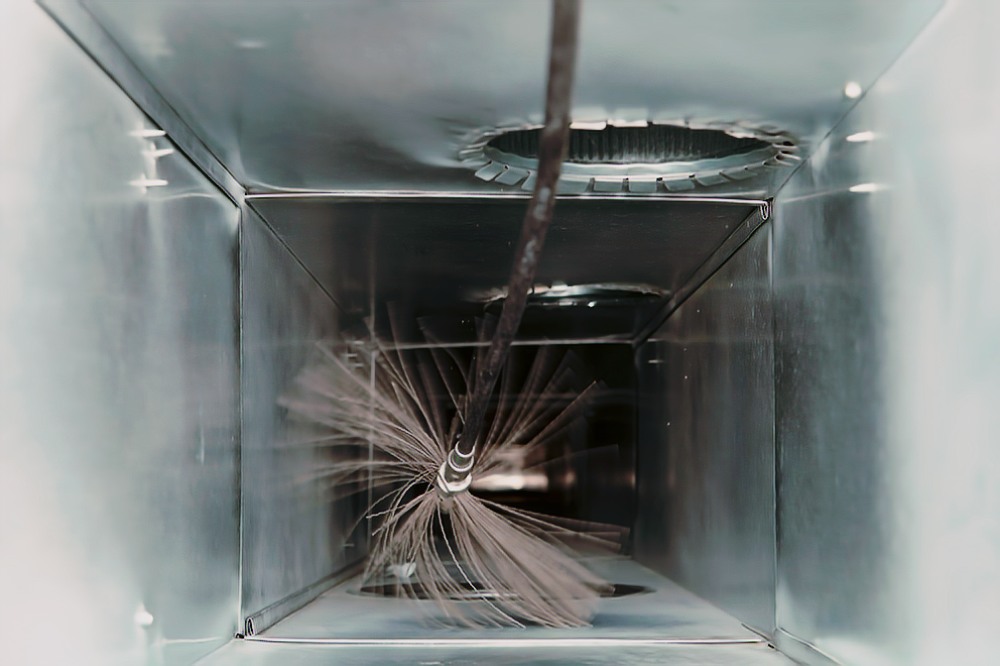Step 1: Inspection
Air duct cleaning begins with a comprehensive evaluation of your heating, ventilation, and air conditioning system. A trained expert will check the ducts for contamination by looking for things like mold, dust, or pests. Before cleaning begins, they will also inspect the ducts for any damage or leaks that may require repairs.
Step 2: Preparation
The specialist will take precautions to safeguard your home’s interior before cleaning the air ducts. Protecting flooring, furniture, and other surfaces from dust and particles may require the use of sheeting. To make it easier to clean in a contained space, they might also block up air vents and registers.
Step 3: Cleaning
Cleaning the ducts properly requires the use of specialist equipment and tools to eliminate dust, filth, and other impurities. A common technique involves collecting and containing the dirt with a powerful vacuum cleaner that has a HEPA filter. To remove tough buildup from the duct walls, the technician may also use compressed air, brushes, or air whips.
Step 4: Cleaning the Other Connected Parts:
Additionally, the fan, coils, and other parts of the air handler unit are cleaned at the same time. That way, you can be confident that no dust or other debris has settled into any part of the HVAC system. Depending on how dirty they are, the air filters are either cleaned or changed.
The effectiveness of the HVAC system and the quality of the air within can be enhanced with regularly cleaned filters. Additionally, any dust or debris that has accumulated in the plenums, the chambers that link the ducts to the HVAC system, is removed during the cleaning process. This aids in maintaining unrestricted airflow throughout the system.
Step 5: Sanitization
The technician may use a sanitizing solution to eliminate any residual bacteria, mold spores, or other germs after cleaning the ducting. The result is better indoor air quality and less chance of contamination in the future. A sealant applied to the ducts as part of the sanitization procedure can help keep dust and debris from building up in the future.
Step 6: Inspection and Testing
The technician will do a final examination of the ducts after cleaning and sanitizing to make sure all impurities have been eliminated. To be sure the cleaning was successful, they could additionally measure the airflow and air quality.
Step 7: Maintenance
To keep your air ducts clean and your HVAC system running at its best, it’s vital to follow a maintenance program. Among these measures could be the routine replacement of air filters, the removal of any debris from the ducts, and the appointment of a professional expert to assess and clean the system at regular intervals.
Benefits of Air Duct Cleaning:
Among the many advantages of having your air ducts cleaned regularly are:
- Airflow Enhancement: Uneven heating and cooling can be caused by unclean air ducts that restrict airflow. If you maintain clean air ducts, air may circulate freely throughout your home, making each space consistently comfortable.
- Efficient Use of Energy: When dirt and dust settle into your air ducts, it can limit airflow and make your heating, ventilation, and air conditioning system work harder to keep the temperature you’ve set. Higher energy bills and system wear and tear can be the results of this. The air ducts in your home can be kept clean to increase ventilation and decrease energy usage.
- Removing Musty Aromas: Mildew, mold, and bacteria can breed in your air ducts and cause musty aromas to build up over time. Maintaining clean air ducts is an easy way to get rid of musty scents and make your home smell better overall.
- Increased Durability of HVAC Systems: The lifespan of an HVAC system can be significantly increased with regular maintenance. Your HVAC system can last longer and save you money on repairs and replacements if you clean the ducts and do other maintenance checks on a regular basis.
- Less Dusting: Clogged air ducts could be the reason you have to dust your home so often. Dust and other particles can settle on your furniture, countertops, and other surfaces in your home when they build up in your air ducts. Cleaning your air ducts on a regular basis will help keep your home cleaner by reducing the amount of dust that settles inside them.
- Enhanced Indoor Air Quality: Dust, pollen, and other allergens can settle into air ducts and be dispersed throughout your home with each HVAC system cycle. By removing these pollutants, regular air duct cleaning improves indoor air quality and lessens the likelihood of respiratory problems and allergies.
Common Misconceptions about Air Duct Cleaning:
It is important to clarify a few points about the detailed procedure of air duct cleaning:
- No Need to Clean Your Air Ducts: It is the belief of some that air ducts are not necessary to be cleaned until an obvious issue arises. Ducts can nevertheless become clogged with dust, pollen, and other allergens over time, even if the accumulation isn’t immediately apparent. You can keep these airborne pollutants out of your home by cleaning it regularly.
- Clean Your Air Ducts on Your Own: Although do-it-yourself air duct cleaning kits are on the market, hiring a professional is usually the best option. The best way to clean and disinfect ductwork is to hire a professional because they have the training, experience, and tools for the job.
Cleaning Air Ducts Can Get Pricey: The square footage of your property and the level of dirt and debris that needs to be removed will determine the total cost of air duct cleaning. Nevertheless, the advantages of reduced air pollution and enhanced HVAC efficiency usually surpass the disadvantages.

